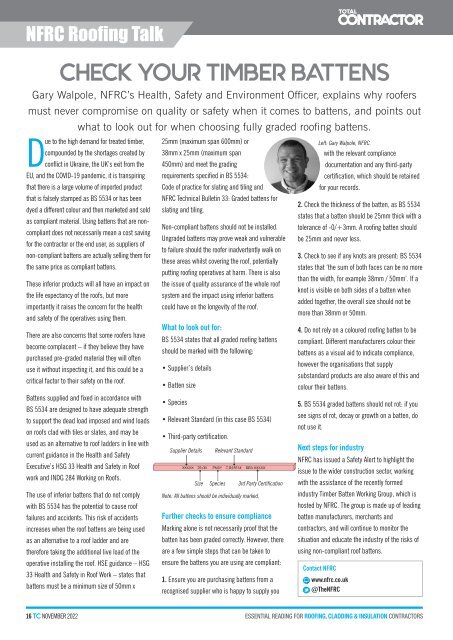November 2022
You also want an ePaper? Increase the reach of your titles
YUMPU automatically turns print PDFs into web optimized ePapers that Google loves.
NFRC Roofing Talk<br />
CHECK YOUR TIMBER BATTENS<br />
Gary Walpole, NFRC’s Health, Safety and Environment Officer, explains why roofers<br />
must never compromise on quality or safety when it comes to battens, and points out<br />
what to look out for when choosing fully graded roofing battens.<br />
Due to the high demand for treated timber,<br />
compounded by the shortages created by<br />
conflict in Ukraine, the UK’s exit from the<br />
EU, and the COVID-19 pandemic, it is transpiring<br />
that there is a large volume of imported product<br />
that is falsely stamped as BS 5534 or has been<br />
dyed a different colour and then marketed and sold<br />
as compliant material. Using battens that are noncompliant<br />
does not necessarily mean a cost saving<br />
for the contractor or the end user, as suppliers of<br />
non-compliant battens are actually selling them for<br />
the same price as compliant battens.<br />
These inferior products will all have an impact on<br />
the life expectancy of the roofs, but more<br />
importantly it raises the concern for the health<br />
and safety of the operatives using them.<br />
There are also concerns that some roofers have<br />
become complacent – if they believe they have<br />
purchased pre-graded material they will often<br />
use it without inspecting it, and this could be a<br />
critical factor to their safety on the roof.<br />
Battens supplied and fixed in accordance with<br />
BS 5534 are designed to have adequate strength<br />
to support the dead load imposed and wind loads<br />
on roofs clad with tiles or slates, and may be<br />
used as an alternative to roof ladders in line with<br />
current guidance in the Health and Safety<br />
Executive’s HSG 33 Health and Safety in Roof<br />
work and INDG 284 Working on Roofs.<br />
The use of inferior battens that do not comply<br />
with BS 5534 has the potential to cause roof<br />
failures and accidents. This risk of accidents<br />
increases when the roof battens are being used<br />
as an alternative to a roof ladder and are<br />
therefore taking the additional live load of the<br />
operative installing the roof. HSE guidance – HSG<br />
33 Health and Safety in Roof Work – states that<br />
battens must be a minimum size of 50mm x<br />
25mm (maximum span 600mm) or<br />
38mm x 25mm (maximum span<br />
450mm) and meet the grading<br />
requirements specified in BS 5534:<br />
Code of practice for slating and tiling and<br />
NFRC Technical Bulletin 33: Graded battens for<br />
slating and tiling.<br />
Non-compliant battens should not be installed.<br />
Ungraded battens may prove weak and vulnerable<br />
to failure should the roofer inadvertently walk on<br />
these areas whilst covering the roof, potentially<br />
putting roofing operatives at harm. There is also<br />
the issue of quality assurance of the whole roof<br />
system and the impact using inferior battens<br />
could have on the longevity of the roof.<br />
What to look out for:<br />
BS 5534 states that all graded roofing battens<br />
should be marked with the following:<br />
• Supplier’s details<br />
• Batten size<br />
• Species<br />
• Relevant Standard (in this case BS 5534)<br />
• Third-party certification.<br />
Supplier Details<br />
Relevant Standard<br />
Size Species 3rd Party Certification<br />
Note: All battens should be individually marked.<br />
Further checks to ensure compliance<br />
Marking alone is not necessarily proof that the<br />
batten has been graded correctly. However, there<br />
are a few simple steps that can be taken to<br />
ensure the battens you are using are compliant:<br />
1. Ensure you are purchasing battens from a<br />
recognised supplier who is happy to supply you<br />
Left: Gary Walpole, NFRC.<br />
with the relevant compliance<br />
documentation and any third-party<br />
certification, which should be retained<br />
for your records.<br />
2. Check the thickness of the batten, as BS 5534<br />
states that a batten should be 25mm thick with a<br />
tolerance of -0/+3mm. A roofing batten should<br />
be 25mm and never less.<br />
3. Check to see if any knots are present: BS 5534<br />
states that ‘the sum of both faces can be no more<br />
than the width, for example 38mm / 50mm’. If a<br />
knot is visible on both sides of a batten when<br />
added together, the overall size should not be<br />
more than 38mm or 50mm.<br />
4. Do not rely on a coloured roofing batten to be<br />
compliant. Different manufacturers colour their<br />
battens as a visual aid to indicate compliance,<br />
however the organisations that supply<br />
substandard products are also aware of this and<br />
colour their battens.<br />
5. BS 5534 graded battens should not rot: if you<br />
see signs of rot, decay or growth on a batten, do<br />
not use it.<br />
Next steps for industry<br />
NFRC has issued a Safety Alert to highlight the<br />
issue to the wider construction sector, working<br />
with the assistance of the recently formed<br />
industry Timber Batten Working Group, which is<br />
hosted by NFRC. The group is made up of leading<br />
batten manufacturers, merchants and<br />
contractors, and will continue to monitor the<br />
situation and educate the industry of the risks of<br />
using non-compliant roof battens.<br />
Contact NFRC<br />
www.nfrc.co.uk<br />
@TheNFRC<br />
16 TC NOVEMBER <strong>2022</strong>

















